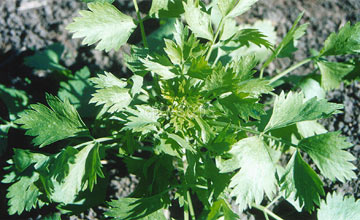Gardening Articles
Chervil - Grow a Little Something That Bestows Youth Upon the Aged
By Penny Ossowski
At the recent Herb Awareness I knew I wanted to buy Chervil but couldn’t for the life of me remember why, I knew I’d read something about it in the heat of summer and decided to wait until the weather cooled before I grew it.
Chervil (Anthriscus cerefolium) is an annual herb related to parsley and carrots and is also known as garden chervil, gourmet's parsley and French parsley and was once known as ‘myrrhis’ because it has a similar aroma to myrrh (you remember the 3 wise men). Chervil is part of the ‘fines herbes’ (parsley, chives, tarragon and chervil) used in French cuisine. It is native to Eastern Europe and was spread throughout Europe by the Romans. Chervil resembles young carrot tops and has a subtle flavour of anise.

Chervil likes a well drained fairly rich soil in a cool position. It will do best in a shaded or partially shaded spot, well mulched to keep its roots cool and soil should be kept moist. Seeds should be planted where they will grow and they don’t like to be transplanted. They will do well in pots which can be positioned to ensure a cool location and look very decorative. They will grow to about 40cm high and a similar width and produce small white flowers. In our climate they are best grown in the cooler months as the heat causes them to bolt to seed. Pinch tops off regularly to encourage young fresh tips, when leaves become older turning bronze and purple they loose their flavour. Re-sow seeds throughout the growing season.
Chervil leaves can be eaten fresh as part of a mesclun mix, they can be used to season poultry, seafood, eggs, cheese, potatoes, vegetables, pesto and added to salads, soups, sandwiches, sauces, vinegars and butter. Because of its subtle flavour chervil should be added at the end of cooking or sprinkled on as a fresh garnish. It can be stored in a zip lock bag for about a week in the refrigerator and can be dried. In some parts of Europe Chervil Soup is served on the Thursday prior to Good Friday.
Medicinally chervil is said to cleanse and purify the blood, aid in the treatment of digestive disorders, high blood pressure, skin problems, curing hiccups and as an eyewash. Eating a whole plant to relieve hiccups is still tried by some people today.
Folklore says that chervil makes one merry, sharpens the wit, bestows youth upon the aged and symbolises sincerity.
In the garden chervil will help repel slugs.
A German visitor to Eden Seeds was so delighted we had Chervil seed because at home she ate them regularly as one her favourite salad greens. You can buy Chervil seeds from our online store.
Chervil Soup
Butter 2 cloves garlic (chopped) knob ginger (Chopped)
2 leeks (sliced) 2 carrots (sliced) 2 stalks celery (sliced)
1 lt water or stock 1 cup chervil (chopped) Salt and Pepper
Brown garlic, ginger in butter in pot over low heat and leeks stir until caramelised.
Add the celery and carrot stir for 10 minutes add water (or stock), bring to boil.
Boil until vegies are tender, add chervil and boil for further minute or two.
Remove vegies from pot and puree in food processor.
Return puree to pot, reheat and add salt and pepper to taste.
Serve with some fresh bread.



